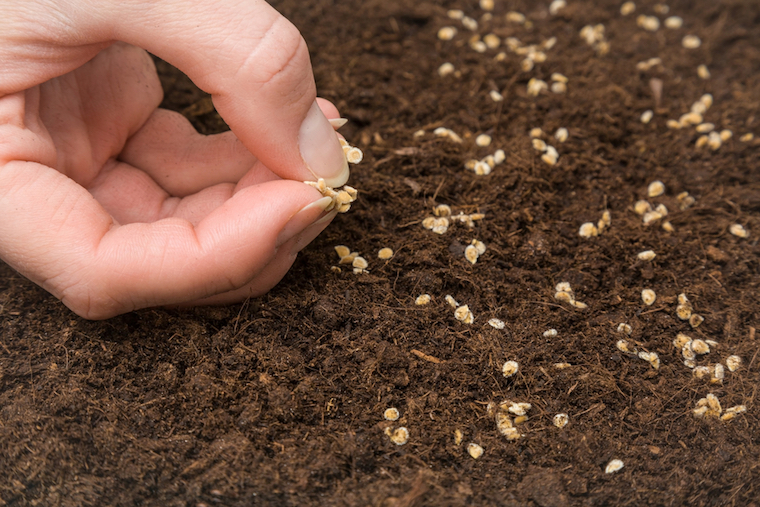
We all like to enjoy the taste of fresh and juicy tomatoes. Nothing tastes better than a vegetable grown by ourselves, so it is always convenient to take advantage of the garden, orchard or even a good pot to grow your fruits and vegetables.
So, if you wonder how to sow tomato seeds to grow them for your consumption, keep reading because, in this article, we teach you how to germinate tomato seeds faster, sow them and take care of them, as they are fast-growing and very easy to care for. Therefore, it is also an ideal activity for the little ones to learn to enjoy plants.
How to germinate tomato seeds faster?

Follow these tips and steps to germinate tomato seeds:
To start, and of course, you will need tomato seeds. You can use tomatoes from the supermarket without any problem, of the variety you prefer, although you will always have better results with tomatoes from organic crops.
The next thing will be to prepare the seedbed or container pot. Tomato seeds germinate much more easily in a controlled environment, so it is better to do it indoors and later, if necessary, transplant them. The container needs to have drainage holes – if it doesn’t, make them.
The substrate is very important: the ideal is to prepare a mixture with a part of peat, another part of worm castings and a third of coconut fiber. Then add vermiculite and perlite to the mixture and stir well. This results in a very light substrate, with excellent drainage and very nutritious, and good moisture retention properties. Water to add moisture after mixing.
When sowing, you can carefully remove the seeds from the tomato itself with a teaspoon or use an even more natural method and cut the tomato into a few slices, leaving the outermost one on each side (don’t throw them away! They are very tasty) and sow, instead of the seeds, the tomato slices themselves with them inside. In either case, don’t plant too deep, as the small tomato seeds will have a hard time reaching the surface then;, tripling the thickness of the seed itself in the substrate is more than enough.
After sowing, water again with a sprayer so that the water does not drag the seeds, and put the seedbed or pot in a warm and shady place until the tomato seedlings start to come out, at which time you should move it to a lighted area.
When to germinate tomato seeds?
Indoors you can do it throughout the year if you control the temperature you expose since the seeds and seedlings do not support temperatures below 15 ºC. However, the best time to do it is between late winter and early spring.
How to germinate tomato seeds on the napkin
It is also possible to germinate tomato seeds on a simple paper napkin. This is called pre-germinated and consists of making the first roots appear before even sowing in a seedbed or pot.
- Prepare an absorbent paper and fold it in half, leaving the seeds inside. You can add two or more layers, using more papers instead of one.
- Put it in a container or Tupperware.
- Moisten the paper by spraying water on it, ensuring that it is completely moistened but not dripping water: it should not drip. Remove any excess water if there is any.
- Keep the container in an area between 16ºC and 28ºC and the dark. It is important to open it once a day for a few minutes so that the air is renewed and the seeds receive oxygen and check, by lifting the paper carefully, that the seeds are fine and that no fungi or other problems have appeared.
How long do tomato seeds take to germinate?
Tomato seeds germinate very quickly, although their specific times depend on the specific variety and type. Even so, most of them will grow in a time of between 1 and 2 weeks, some doing it in even less.
Caring for sprouted tomato seeds
Once the seedlings have germinated, it will be necessary to move them to a warm and sunny location, although if the sun is intense, it is better to opt for abundant but indirect light. Keep the substrate slightly damp and keep them away from excessively close sources of heat or cold.
If you have pre-germinated them, once they have their small white roots, you should transfer them to the substrate, placing them very carefully with the roots under the ground and the rest of the plant on the surface. Also, keep in mind that if you have used the substrate mix, we have recommended, they will not need fertilizer at the moment.
Tomato care
To finish, we will indicate some of the care of tomato plants :
Irrigation: abundant and frequent, but without flooding.
Sun: abundant, direct once the plant grows.
Climate: 15 or 28 ºC.
Pruning: when axillary shoots begin to appear if the variety produces them. Learn how to prune tomatoes by entering here.
Subscriber: regular every 15 days.
Entutorado: necessary so that the fruits are not on the ground.





